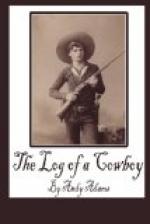I was amongst the first to be interviewed by the Indian agent, and on being excused, I made the acquaintance of one of two priests who were with the party. He was a rosy-cheeked, well-fed old padre, who informed me that he had been stationed among the Blackfeet for over twenty years, and that he had labored long with the government to assist these Indians. The cows in our herd, which were to be distributed amongst the Indian families for domestic purposes, were there at his earnest solicitation. I asked him if these cows would not perish during the long winter—my recollection was still vivid of the touch of squaw winter we had experienced some two weeks previous. But he assured me that the winters were dry, if cold, and his people had made some progress in the ways of civilization, and had provided shelter and forage against the wintry weather. He informed me that previous to his labors amongst the Blackfeet their ponies wintered without loss on the native grasses, though he had since taught them to make hay, and in anticipation of receiving these cows, such families as were entitled to share in the division had amply provided for the animals’ sustenance.
Lovell returned with the party to the agency, and we were to bring up the herd for classification early in the morning. Flood informed us that a beef pasture had been built that summer for the steers, while the cows would be held under herd by the military, pending their distribution. We spent our last night with the herd singing songs, until the first guard called the relief, when realizing the lateness of the hour, we burrowed into our blankets.
“I don’t know how you fellows feel about it,” said Quince Forrest, when the first guard were relieved and they had returned to camp, “but I bade those cows good-by on their beds to-night without a regret or a tear. The novelty of night-herding loses its charm with me when it’s drawn out over five months. I might be fool enough to make another such trip, but I ’d rather be the Indian and let the other fellow drive the cows to me—there ’s a heap more comfort in it.”




